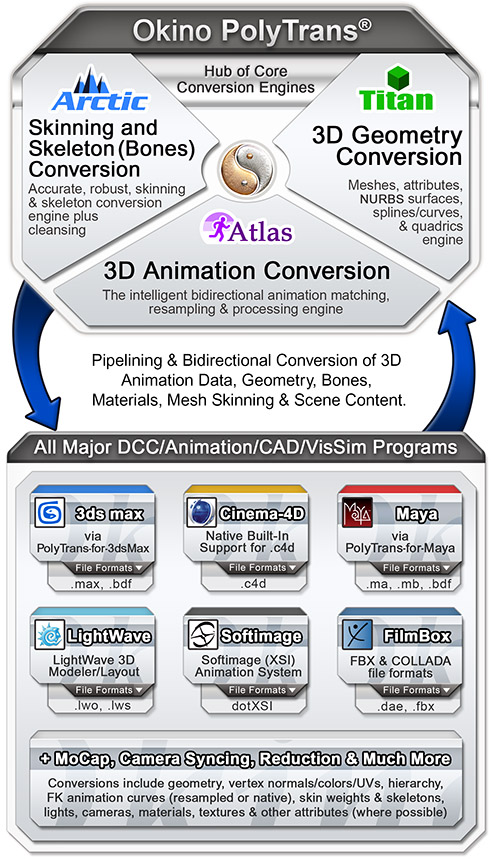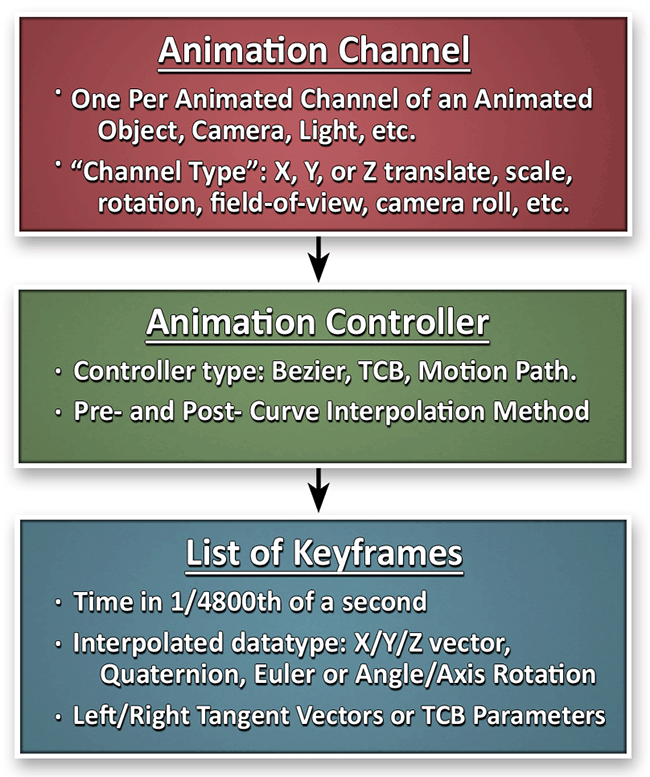| You are here: Home » Products » PolyTrans|CAD+DCC » Animation Conversions |

Bidirectional animation conversion is one of the most crucial and critcal aspects of the PolyTrans software package to our DCC user base. It is well into its third decade of daily development at Okino and has been used extensively throughout the 3D production markets for serious commercial work. Okino pioneered and brought to market the first and main animation cross conversion package, handling all main 3D file formats and animation packages. That continues to this very day. Bi-directional conversion of animation data, to a specific numerical tolerance, is provided between 3ds Max, CINEMA-4D, LightWave, Maya, COLLADA, DirectX, FBX and U3D.
Simply put, animation conversion with tolerance-based guaranteed results is a hard problem. There is no simple process to transfer animation data between all 3D animation programs. To convert between the different mathematics used by each major 3D animation package, and their different methods of internally representing 3D animated objects, Okino has developed a unique "animation conversion engine". This engine allows raw animation data to be imported from the most popular 3D animation programs, accurately played back in real-time, resampled to alternate forms of animation mathematical representation and exported to other 3D animation file formats.
As shown in the right diagram, the internal "engine" stores the raw imported animation data as a series of hierarchical "channels" (such as X/Y/Z translation), each of which has a "controller" which simulates the most popular animation interpolation methods (Bezier, TCB, etc.), and to each controller a series of keyframes representing the animation curve over time. This ensures accurate retention of the imported animation data.A vital aspect of accurate animation conversion is the "keyframe resampling & reduction" algorithm of PolyTrans; as shown below, this algorithm allows incompatible animation methods to be converted with tolerance-based accuracy. The example below shows how X/Y/Z Euler rotations (from Lightwave or Maya) are converted into the mathematically different Quaternion rotation method (used by DirectX and 3ds Max, for example).
Click either diagram for a larger image.
The core animation conversion technology in PolyTrans is called our "Arctic" toolkit. This is used by our 3D converters which need animation & skinning support to correct for complex problems encountered while cross converting animation, skinning, Biped and skeleton data. For animation, the toolkit ensures that all the animation channels are sampled accordingly if there are any quirks that cannot be accomodated in the destination file format, such as procedural controllers from 3ds Max being exported to Maya, or weighted Bezier tangent vectors. For skinning, Arctic provides the best bidirectional skinning (mesh deformation) in any 3D software package; decades of refinement and customer field usage allows it to automatically correct for problematic skinning conversion issues. For example, with skeleton conversions, the Arctic toolkit provides automatic bone realignment when importing skeleton data into 3ds Max (which requires X-axis aligned bones). The Artic toolkit is also intelligent to create "lost bind" poses which are sometimes non-existent in Maya.
Please feel free to send email to the developers of the animation aspect of PolyTrans and ask any questions you may have about a specific converter or a specific conversion route. The developers can be reached at support@okino.com.




